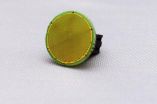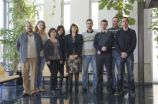(Press-News.org) Endlessly frustrated by congested roads, computer scientists at California State University, in Fullerton have developed a satellite navigation system, GeoTNavi, which hooks into historical traffic data and current vehicle movements to find the shortest commute and avoid the traffic jams.
Writing in the latest issue of the International Journal of Data Mining, Modelling and Management, Shawn Wang and colleagues explain how the California highway system is one of the most complicated and busiest highway systems in the USA with well over 83% of urban interstate congestion. Not without irony, they point out that traffic jams and unpredictable communication delays are not unique to US cities. A satellite navigation system that could drive around jams and avoid gridlock would be a boon to commuters, truckers, public transportation, emergency services and logistics organizations the world over.
They point out that "sat-nav" systems have built-in updateable maps, while some are linked to web-based mapping services. There also exist services that monitor traffic flow and alert drivers to potential trouble often based on calls from drivers to local radio news and road authorities depending on where you are in the world, while some systems have automated reporting from a select group of sat-nav users. There is a third source of information based on historical traffic movement databases. The team has now brought these various pieces of traffic information - maps, historical data and real-time driving conditions - together in a prototype system that could see an end to traffic jams.
The system works like a standard sat-nav in the first instance, but with the added benefit of not only calculating the driver's route from A to B but also basing its choice of highways on the time of travel and the historical data. The system can thus take the driver from A to B via C if necessary. The system also monitors the real-time traffic data and continuously assesses the route so that if there's a traffic jam, accident or other incident on the road from A to B it can take you via D and also avoid the gridlock at D. The team says their use of state-of-the-art data warehousing and data mining techniques makes this a very fast and efficient process.
"The GeoTNavi system is unique in that it takes the time dimension into consideration and uses real traffic data," the team explains. The team has tested their system against the two standard algorithms used by sat-nav route planners, Dijkstra and A*. Those two systems do not have the real-time or historical traffic inputs, of course. They used twenty weeks of historical data in the GeoTNavi route planning and set off across Los Angeles and Orange County on a Wednesday morning at 9 am, finding routes from A to B, from A to E and even A to Z. In all, tests were run on 10 randomly selected destination addresses. The conventional systems worked well for distances less than 10 miles, but once the route was 20, 30 or more miles, both degraded quickly in terms of finding the best route given congestion and traffic jam problems.
If every driver were able to choose the optimal route then ultimately the transportation network would reach an ideal equilibrium of zero congestion. The team points out that California is miles and miles from such an equilibrium, but GeoTNavi once optimized might help it approach such a state.
###
"GeoTNavi – smart navigation using geo-temporal traffic information" in Int. J. Data Mining, Modelling and Management, 2013, 5, 20-36
Smart satnav drives around the blue highway blues
2013-02-07
ELSE PRESS RELEASES FROM THIS DATE:
Permanent stress can cause type 2 diabetes in men
2013-02-07
Men who reported permanent stress have a significantly higher risk of developing type 2 diabetes than men who reported no stress. This is the finding of a 35-year prospective follow-up study of 7,500 men in Gothenburg, by the University of Gothenburg, Sweden.
Since the 1970s, a large population based cohort study has been undertaken at the Sahlgrenska Academy, University of Gothenburg to monitor the health of men born in Gothenburg between 1915 and 1925.
Using this unique material, researchers are now able to show that permanent stress significantly increases the risk ...
A Spanish breakthrough allows the electroporation of cell cultures for less than 1 Euro
2013-02-07
Researchers from the Polytechnic University of Catalonia have developed a technique that improves and cuts the cost of a technique called electroporation, which involves opening pores in cell membranes using an electric field to introduce substances like drugs and DNA. Current methods are aggressive and expensive whereas the new system manages to apply low voltage electroporation with a small printed circuit board, which costs less than a Euro per unit and does not damage cells.
Two US firms in Boston and San Francisco operating in the biotechnology equipment sector have ...
Asians are far more likely than Anglos to be college-educated
2013-02-07
Asians (about 60 percent) are much more likely to be college-educated than Anglos (under 40 percent), according to Rice University's Kinder Institute Houston Area Asian Survey, the first systematic look at the local Asian population based on three surveys conducted over a 16-year period. The findings were released today by Stephen Klineberg, Kinder Institute co-director and Rice sociologist, at an event hosted by the institute at the Asia Society Texas Center.
The surveys, conducted in 1995, 2002 and 2011 in conjunction with the annual Kinder Institute Houston Area Survey, ...
Research could ensure that crowd work becomes a career option, not a dead end
2013-02-07
PITTSBURGH—Crowdsourcing is an effective way to mobilize people to accomplish tasks on a global scale, but some researchers fear that crowd work for pay could easily become the high-tech equivalent of a sweat shop. Trivial work for rock bottom pay isn't inevitable, however, and they've outlined a research agenda to make crowd work both intellectually and monetarily rewarding.
Leading researchers in crowd work from Carnegie Mellon University and other institutions will present their plan, hashed out in a special workshop last spring, at the Association for Computing Machinery's ...
Veterans with mild traumatic brain injury have brain abnormalities
2013-02-07
Mild traumatic brain injury (TBI), including concussion, is one of the most common types of neurological disorder, affecting approximately 1.3 million Americans annually. It has received more attention recently because of its frequency and impact among two groups of patients: professional athletes, especially football players; and soldiers returning from mid-east conflicts with blast-related TBI. An estimated 10 to 20 percent of the more than 2 million U.S. soldiers deployed in Iraq or Afghanistan have experienced TBI.
A recent study by psychiatrists with the Iowa City ...
A privacy risk in your DNA
2013-02-07
The growing ease of DNA sequencing has led to enormous advancements in the scientific field. Through extensive networked databases, researchers can access genetic information to gain valuable knowledge about causative and preventative factors for disease, and identify new targets for future treatments. But the wider availability of such information also has a significant downside — the risk of revealing personal information.
Researchers from Tel Aviv University and the Whitehead Institute of Biomedical Research in Cambridge, MA, have developed an algorithm that can identify ...
UAB researchers cure type 1 diabetes in dogs
2013-02-07
Researchers from the Universitat Autònoma de Barcelona (UAB), led by Fàtima Bosch, have shown for the first time that it is possible to cure diabetes in large animals with a single session of gene therapy. As published this week in Diabetes, the principal journal for research on the disease, after a single gene therapy session, the dogs recover their health and no longer show symptoms of the disease. In some cases, monitoring continued for over four years, with no recurrence of symptoms.
The therapy is minimally invasive. It consists of a single session of various injections ...
Key protein revealed as trigger for stem cell development
2013-02-07
A natural trigger that enables stem cells to become any cell-type in the body has been discovered by scientists.
Researchers have identified a protein that kick-starts the process by which stem cells can develop to into different cells in the body, for instance liver or brain cells.
Their discovery could help scientists improve techniques enabling them to turn stem cells into other cell types in the laboratory. These could then be used to test drugs or help create therapies for degenerative conditions such as Parkinson's disease, motor neurone disease, multiple sclerosis ...
How a fall in duck hunting is shooting a financial hole into conservation efforts
2013-02-07
The annual duck hunting season in the United States is traditionally big business, but while bird numbers are rising faster than they have for decades, the number of hunters continues to fall. Far from being good news for ducks a new study in the Wildlife Society Bulletin shows how the loss of revenue from 'duck stamps' could result in millions of lost dollars for vital conservation work.
"The last 15 years have brought hunting opportunities not seen since the turn of the last century," said Dr Mark Vrtiska from Nebraska Game and Parks Commission. "The waterfowl population ...
Information Technology improves patient care and increases privacy, MU informatics expert says
2013-02-07
The federal government invested more than $25 billion in health information technology (IT) as a result of the American Reinvestment and Recovery Act; yet, little is known about how IT applications improve patient safety and protect their privacy. Now, a University of Missouri nursing informatics expert suggests that sophisticated IT leads to more robust and integrated communication strategies among clinical staff, which allows staff to more efficiently coordinate care and better protect patient privacy.
Greg Alexander, an associate professor in the MU Sinclair School ...

